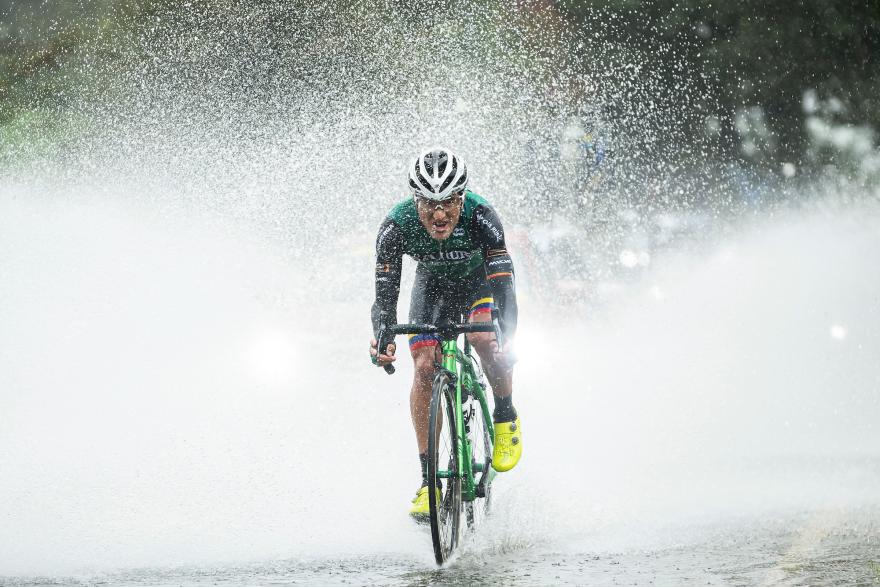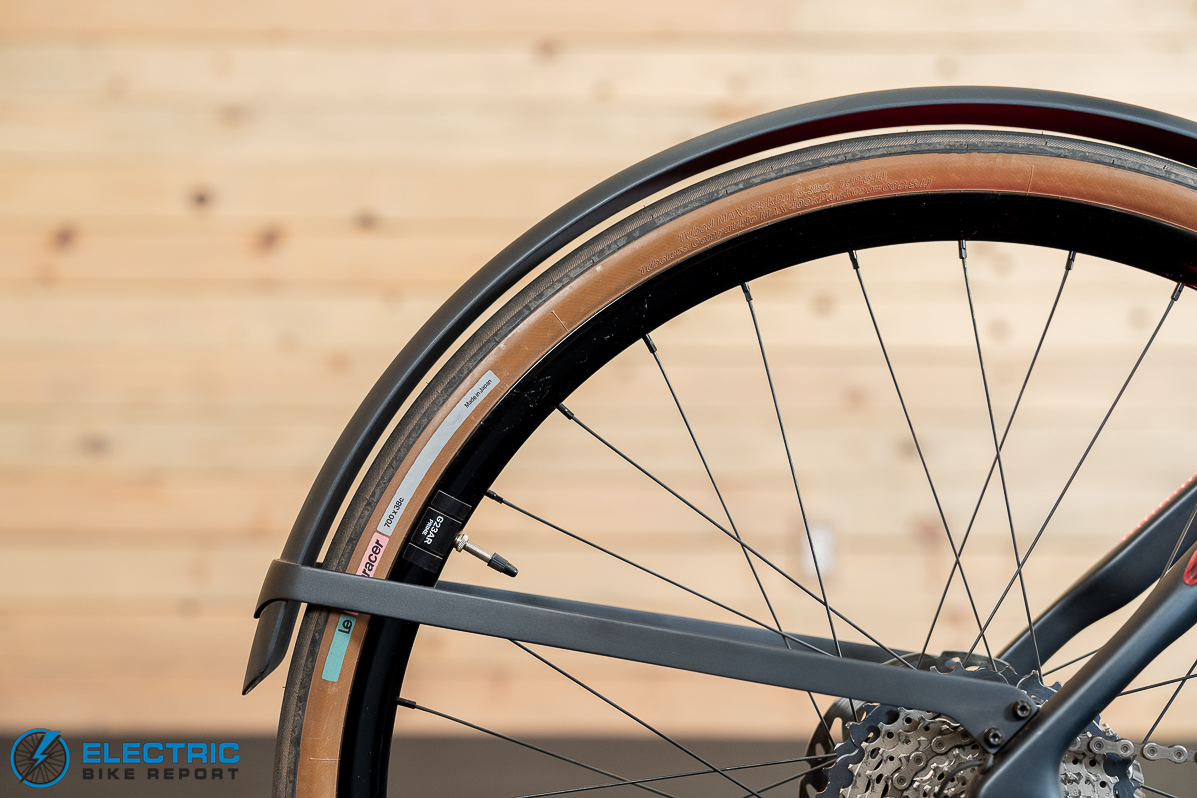
8 Tips for Riding in the Rain—How to Stay Comfortable While Pedaling
Share

My Norwegian ancestors were known to say, “Det finnes ikke dårlig vær, bare dårlig klær!” To the rest of us, that translates as, “There’s no bad weather, only bad clothes.” It’s a point reasonable people could argue, but riding in the rain doesn’t have to mean suffering, and we’ve got a set of tips that can make riding in the rain no big thing.
You don’t need all of these to make peace with water falling from the heavens, but every one of them can make those wet days a bit more pleasant.
Rain Jacket

The single most helpful tip we can offer for riding in the rain is to buy a good rain jacket. The secret to comfort in the rain is keeping your core warm, and the drier you are, the easier that is. A good rain jacket will keep the weather off your torso, which will help you stay comfortable.
A good rain jacket will have long sleeves so you can bend forward and reach the handlebar without the sleeves riding up your forearms. Many rain jackets also have a drop tail, that is, a long tail in back to protect from spray coming off the rear wheel. Many will have either zippers in the armpits (pit zips) or breathable panels to allow moisture to escape. Some will use a more water-resistant material in the front and something more breathable across the back; such jackets are aimed at riders who will be pedaling hard.
Other details that can be handy: A storm flap or waterproof zipper will help keep your front dry. A high collar can help prevent rain from finding its way into the jacket. Some offer adjustable cuffs on the sleeves to keep rain from blowing in. Almost all of them will feature reflective hits to help make you more visible to drivers and pedestrians. Some are small enough and light enough to keep in a backpack to they can be accessed in the event of a sudden downpour, and some of those can be packed into a pocket to make managing them as easy as possible when not in use.
One note about the value of a truly waterproof jacket: The more waterproof a jacket is, the less breathable it is. That means that any perspiration your body releases will stay inside the jacket, so while you’ll be protected from rain that may be cold, the inside of the jacket will feel like a rainforest.
Fenders

We’re pleased that fenders have become an accepted part of an e-bike’s standard accessory package. Fenders do more than keep you dry when it’s raining. They also keep spray from reaching you if you get surprised by a puddle.
Here’s the thing about fenders that we don’t always know until it’s too late: Not all fenders are created equal. Fender length matters. The best fenders are long, often looking longer than necessary. Fenders that are long enough will keep your feet dry or nearly so and will prevent spray from the e-bike’s rear tire from painting a wet stripe up your back. If after riding in a downpour you find that your back is wet or your feet are soaked, you may need longer fenders.
Waterproof backpack
There’s a particular kind of horror we feel when we open our backpack and discover the contents are wet. Of course, laptop computers are more averse to water than a cat, though perhaps a bit more stoic. You can save yourself a degree of worry by picking up a backpack that combines the waterproof performance of a drybag with the protection of a padded laptop sleeve.
As we progress through the other items below, it will become apparent that a sizable backpack is handy because to be truly comfortable in the rain, you may find yourself putting your shoes, socks and pants inside your backpack and donning items specifically for that rainy ride.
Rain pants
A good rain jacket and waterproof backpack are necessities for anyone commuting in the rain. Once those are covered, the next most important item a rider can pick up to improve their comfort while pedaling in the rain is a set of rain pants.
Rain pants come in two different broad classes. Some are form-fitting enough that they are meant to be worn as your only pants, while some are cut loose enough to fit over chinos, slacks or jeans. Most don’t include traditional front pockets so that they don’t collect water, though some will include a single hip pocket.
Like some rain jackets, rain pants will sometimes feature a water-resistant fabric in the front with a more breathable fabric in the rear to prevent the rainforest effect. Others are weatherproof all the way around. Most are nothing more than a shell and don’t include any insulation.
Gloves

Riding an e-bike requires some dexterity, less because of steering than operating the brakes and gears. For this reason, we rarely recommend mittens, even when conditions turn both cold and wet. If conditions aren’t too cold, neoprene gloves can provide sufficient warmth to make wet hands a non-issue. Neoprene gloves generally do a good job of providing grip when it’s wet, as well.
In truly cold conditions (such as when the mercury drops below 45 degrees, a waterproof winter glove will provide more comfort. Warm hands are the goal here; they will still be damp from perspiration, but at least that moisture will be warm.
It’s important to check gloves not only for fit, but dexterity, which is one reason neoprene gloves rank high on our list. Some waterproof winter gloves are filled with so much insulation that the dexterity necessary to brake and shift gears can be lost.
Hat
Keeping your head protected from the elements is another notable ingredient in staying comfortable when riding in the rain. A waterproof cap will keep the weather out and the heat in, too. This would be an occasion to stick with a cycling cap with a short brim; baseball caps, thanks to their longer bill, tend to catch the wind and get blown around, and most won’t fit beneath a helmet. The short brim of a cycling cap also does a fair job of keeping rain out of your eyes, which is handy, considering eyewear is often useless in the rain.
Waterproof socks

If your e-bike’s front fender isn’t long enough, your feet will notify you. To keep your feet dry, and hopefully happy, an alternative to a longer fender can be provided by waterproof socks. Most waterproof socks run twice the thickness of athletic socks, so they are most comfortable in a pair of loose shoes.
Lube your chain

Not all chain lubes are created equal. To paraphrase George Orwell, some lubes are more equal than others. During the monsoon season, or if you simply ride on wet streets, if a lube is too light, even a single ride in wet weather can wash the lube away, leaving behind an orange chain. Choose a lube intended for wet conditions. These lubes tend to be heavier and stickier, bad qualities for dry and dusty conditions, but ideal strengths on any ride that turns damp.
